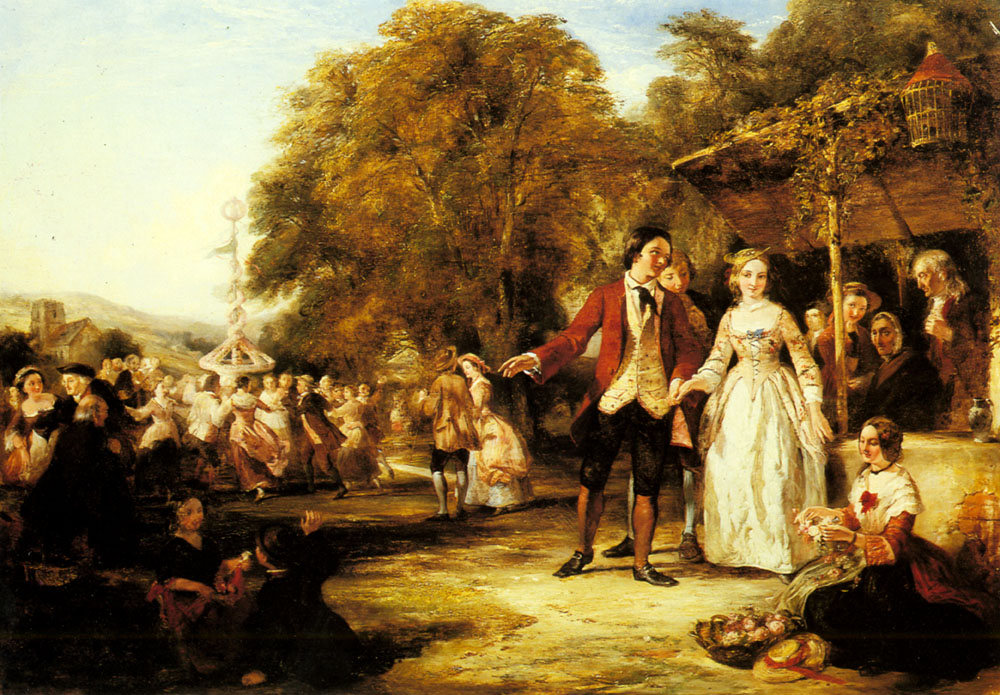The song “John (Joan) to the Maypole” dates back at least to 1600, we know several text versions with the same title but also with different titles, (to “May-day Country Mirth”, “The Young Lads and Lasses”, ” Innocent Recreation “,” The Disappointment “) the first printed version dates back to 1630 when the melody is attributed to Felix White, and we find it in the collection” The Pills to Purge Melancholy “by Thomas D’Urfey c. 1720.

The song describes a typical May Day on the lawn: couples dance around the May Pole to contend for the coveted award, the May garland. The winning couple will become King and Queen of May.
To organize May Day feast we need just a green, that is an open space outside the village, a well planted pole in the middle of the lawn, decorated with flower garlands, some “summer houses” where to sit in the shade and refresh with drinks.
In the painting by Charles Robert Leslie we see a scene celebrating the May with Queen Elizabeth depicted on the right in the foreground while being entertained by a jester. On the expanse of the second floor stands the May pole decorated with green garlands; around the pole the dances are taking place and the characters dressed by Robin Hood, Lady Marian, Fra Tack, but also a seahorse, a dragon and a buffoon (the classic characters of mummers and Morris) are well distinguishable.

In the Victorian painting by William Powell Frith we find again the same situation described in the late medieval period: in the distance on the left stands out the profile of a church, not by chance: it was in fact the church that financed the May celebrations; with the beer sold, the parish church was maintained or the alms were distributed to the poor.
It is not even so strange that Beltane feast has merged under the control of the Catholic Church, but the Puritans were horrified by all May customs, thus May Pole and related celebrations see moments of obscurantism alternated with moments of tolerance (see more)
Joan to the Maypole
Chorus
Joan to the Maypole away, let us on,
The time is swift and will be gone;
There go the lasses away to the green,
Where their beauties may be seen
I
Bess, Moll, Kate, Doll,
All the gay lasses
have lads to attend them,
Hodge, Nick, Tom, Dick,
Jolly brave dancers,
and who can mend them?
[Chorus]
II
Did you not see the Lord of the May
Walk along in his rich array?
There goes the lass that is only his,
See how they meet and how they kiss.
Come Will, run Gill,
Or dost thou list to lose thy labour(1);
Kit Crowd scrape loud,
Tickle her, Tom, with a pipe and tabor!(2).
[Chorus]
III
There is not any that shall out-vie
My little pretty Joan and I,
For I’m sure I can dance as well
As Robin, Jenny, Tom, or Nell.
Last year, we were here,
When Ruff Ralph he played us a bourée,
And we, merrily
Thumped it about and gained the glory.
IV
Now, if we hold out
as we do begin,
Joan and I the prize shall win(3);
Nay, if we live till another day (4),
I’ll make thee lady of the May.
Dance round, skip, bound,
Turn and kiss, and then for a greeting.
Now, Joan, we’ve done,
Fare thee well
till the next merry meeting.
[Chorus]
FOOTNOTES
1) the exhortation refers to the musicians who are not yet ready with their instruments to kick off the dance.
2) Pipe and tabor or tabor-pipe is the three-hole flute associated with the tambourine, the flute is played with one hand and with the other one it is accompanied by a tambourine (see more)
3) the May garland at stake
4) it is not clear whether the election dethroned the previous couple immediately or is the title valid for the following year.
The tune is from “Margaret Board Lute Book” (here) the manuscript in the private collection of Robert Spencer, has been dated c1620 up to 1636 (it seems that lady Margaret took lessons from John Dowland).
in “The new standard song book”- (J.E.Carpenter) – 1866 with the title: “very popular at the time of Charles I”. A version of nine verses is featured in the broadside titled “The May-Day Country Mirth Or, The Young Lads and Lasses’ Innocent Recreation, Which is to be priz’d before Courtly Pomp and Pastime.” Bodleian collection, Douce Ballads 2 (152a ) and The Roxburghe Ballads: Illustrating the Last Years of the Stuarts Vol. 7, Part 1, edited by J. Woodfall Ebsworth (Hertford: Ballad Society, 1890) (see)
second part “Come, Lasses and Lads”
LINK
http://ontanomagico.altervista.org/intorno-al-palo-del-maggio.html
http://www.maymorning.co.uk/426023492
http://tunearch.org/wiki/Annotation:Joan_to_the_Maypole
http://cbladey.com/mayjack/maysong.html#JOAN%20TO%20THE%20MAYPOLE

